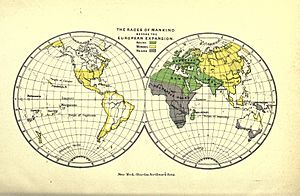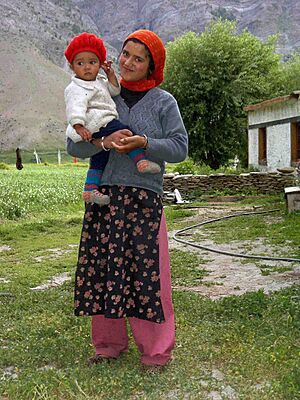Historical definitions of races in India facts for kids
Various attempts were made, especially during the time of British rule in India, to group people based on their race. However, after India gained independence, the government decided to stop these racial classifications. The goal was to encourage everyone to see each other as equal, without differences based on race. Because of this, the 1951 Census of India and all later national surveys in India do not recognize any racial groups.
In the past, some experts during the British colonial period tried to find ways to classify different groups in India. They used popular ideas about race that were common in Europe at the time. The British census in India often used these racial classifications, sometimes mixing them with ideas about the caste system.
Old Ideas About Human Races
In the late 1800s and early 1900s, a way of thinking called scientific racism tried to divide humans into three main "races." These groups were based on what people thought were common physical features. The terms used were Caucasoid, Mongoloid, and Negroid. It's important to remember that these ideas are now considered outdated and harmful. Modern science does not support dividing humans into distinct races in this way.
An American anthropologist named Carleton S. Coon once wrote that India was the "easternmost outpost" of the Caucasoid racial region. He described a group called the Indid race as living in the Indian subcontinent, starting from the Khyber Pass. Another American expert, John Montgomery Cooper, said in 1945 that most people in India were Caucasoid. He noted that their features, hair, and nose shapes were similar to those typically described as Caucasoid. He also mentioned that only in very remote parts of India might there be traces of other groups.
Classifying People in India
In the 1840s and 1850s, some German language experts believed that people who spoke Indo-European languages in India, Persia (modern-day Iran), and Europe belonged to the same culture and race. This idea led to a difference being made between the Indo-Aryan peoples in northern India and the Dravidian peoples. Most Dravidian people live in southern India, but smaller groups can be found in places like Baluchistan in the northwest and parts of Bihar Province in the east.
Even though many experts now classify Dravidians as Caucasoid, especially the "Mediterranean-Caucasoid" type, their racial status was debated for a long time. In 1898, an expert named Friedrich Ratzel thought Dravidians had "Mongolian features." He even suggested they might be closely related to people in Tibet, whom he considered part of the Mongol race.
Other researchers had different ideas. Edgar Thurston described a group he called Homo Dravida and thought they were similar to Australoids, with some mixing from Caucasoid (Indo-Aryan) groups. He pointed to things like the use of the boomerang by some Indian warriors and the skill of tree-climbing among certain groups as evidence.
In 1900, anthropologist Joseph Deniker suggested that the Dravidian race was connected to both Indonesian and Australian groups. He said this "South Indian" race was common among people in Southern India who spoke Dravidian languages. He also grouped Dravidians as a "subrace" with "Curly or Wavy Hair Dark Skin," which also included Ethiopian and Australian groups. Deniker also noted that the "Indian race," found among Afghans, Rajputs, and Brahmins in North India, had mixed with many other groups over time.
However, in 1915, Arnold Wright mentioned that Dr. Caldwell believed in the Caucasoid physical type for Dravidians. He pointed to the Todas, a Dravidian tribe, as an example. Many people thought the Todas looked very Caucasoid, even comparing them to Celts, Romans, or Jews. Wright also noted that other experts like Richard Lydekker and Flowers classified Dravidians as Caucasoid. Later, in his 1939 book The Races of Europe, Carleton S. Coon agreed with this view. He classified Dravidians as Caucasoid because of their skull structure and other physical features like noses, eyes, and hair. By the 20th century, many anthropologists classified Dravidians as Caucasoid, with the "Mediterranean-Caucasoid" type being the most common.
|
See also
- Mongoloid race
- Brown people
- Asian people
- Ethnic groups of South Asia
- Genetics and archaeogenetics of South Asia
- mtDNA haplogroups in populations of South Asia
- Y-DNA haplogroups in populations of South Asia
- Anglo-Indian
- Afro-Asians
- Indo-African (disambiguation)
- Indian South Africans
- Afro-Asians in South Asia
- Telingan



